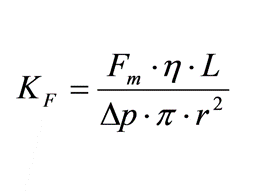One of the most important characteristics describing the column properties is column permeability. Term permeability refers to the column packed with a stationary phase (particles or monolith) and describes how easy flows the liquid (mobile phase) through the column.
At given pressure, the higher is flow through the column the higher is the permeability of the column. More exact definition of the permeability is described as the volume flow of fluid per unit time per unit area per unit pressure gradient.
In case of liquid chromatography, there is limiting pressure that has practical uses, so if particle s with small diameter are used (to have as low plate height as possible), then the column with limited length and mobile phase with a low viscosity have to be used.

The column permeability can be easily calculated from the flow and column characteristics using the embeded equation. Here the Fm is the mobile-phase flowrate, η is the mobile-phase viscosity, Δp is the pressure drop across the column, L is the column length, and r is the column inner radius.
One can see that the flow of the mobile phase through the column is directly proportional to the pressure across the column and the fourth power of the particle diameter and inversely proportional to the product of the mobile phase viscosity and the length of the column.
2 replies on “Column permeability”
Can you calculate an approximate pressure value that will act on a column when running an analysis? If you have a regular 250×4.6mm column, with 5um partcies and an aqueous (viscocity 0.89 cP) mobile phase at flow 1ml/min?
Thank you.
Hi David,
yes, once you know (determine) column permeability you can use this value to calculate expected pressure at given experimental conditions. All you have to do is to transfer units to SI units and then calculate pressure as p = (flow x viscosity x length) / (permeability x pi x radius^2).
If you need more help, give me value of your column permeability and I will show you how to do the calculation.